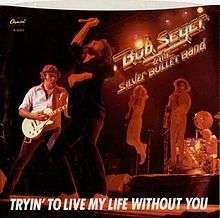Tryin' to Live My Life Without You
"Trying to Live My Life Without You" is a song written by Eugene Williams, originally popularized by soul singer Otis Clay. In early 1973 it reached #102 on the Billboard Bubbling Under chart. It has since been covered by several other artists, most notably Bob Seger on his 1981 Nine Tonight album, and Brinsley Schwarz. On February 17, 1973, Clay performed the song on Soul Train.[1]
Writing
The song is sung from the point of view of a man who is addressing his former lover. During the song's verses the narrator tells of various habits he has had over his lifetime, such as smoking "five packs of cigarettes a day" and drinking "four or five bottles of wine." In the prechorus, he states that breaking those former habits was difficult, but not nearly as difficult as getting over the girl and forgetting the love they shared.
Bob Seger version
Bob Seger's cover of the song is the most successful version of the song, reaching number five on the pop singles charts. It is known for Seger's spoken prelude on top of the bassline: "Alright, you guys feel funky tonight? ... This is an old Memphis song, old Memphis song...." The Nine Tonight liner notes claim that Seger's saxophone player, Alto Reed, played all the saxophones heard on that song, at the same time. Most likely this is possible from studio overdubbing on top of the live performance.
Weekly charts
|
Year-end charts
|
References
External links
Song Lyrics
|
|---|
|
|
|
| The Bob Seger System albums | |
|---|
|
| Bob Seger solo albums | |
|---|
|
Bob Seger & the
Silver Bullet Band albums | |
|---|
|
| Live albums | |
|---|
|
| Compilations | |
|---|
|
| Singles | |
|---|
|
| Related articles | |
|---|
|
 Book:Bob Seger Book:Bob Seger |

